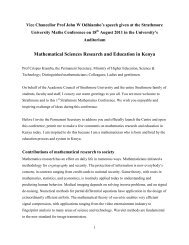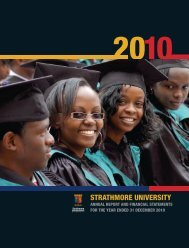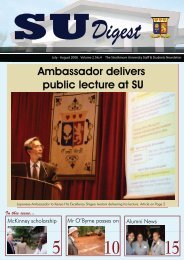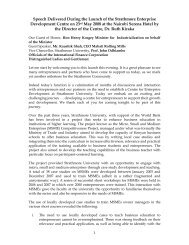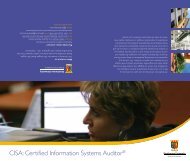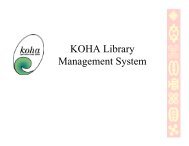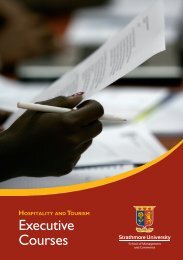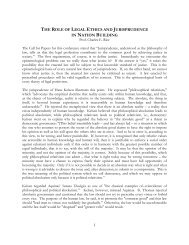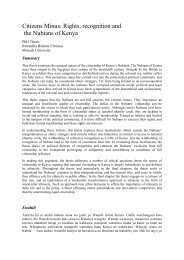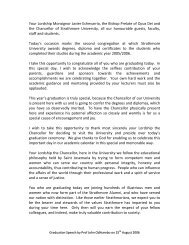magazine - Strathmore University
magazine - Strathmore University
magazine - Strathmore University
- No tags were found...
Create successful ePaper yourself
Turn your PDF publications into a flip-book with our unique Google optimized e-Paper software.
ImpactIssue 6<br />
December 2009<br />
The <strong>magazine</strong> of the ACU PR, Marketing and<br />
Communications Network<br />
Welcome to the<br />
sixth edition of<br />
Impact!<br />
The articles in this issue focus on crisis planning<br />
on campus, the role of photography in univ er -<br />
sity marketing, and how best to build relation -<br />
ships between academic researchers and the wider<br />
community. In our regular Profile section, Eric Kath -<br />
enya of <strong>Strathmore</strong> <strong>University</strong> shares his experiences<br />
of developing his university’s website.<br />
Once again, the content of our <strong>magazine</strong> reflects<br />
the diverse communications challenges faced by our<br />
Network members across the Commonwealth. We<br />
hope to pick up these, amongst many other issues, at<br />
our forthcoming ACU PR, Marketing and Comm un -<br />
ications Conference. This, the Network’s next biennial<br />
conference, will be held in Melbourne, Australia, from<br />
25-26 November 2010 and is entitled ‘Changing<br />
Times, Changing Markets and Changing Priorities’.<br />
For further details, please see our news section.<br />
However, full information will soon be sent out via our<br />
email list and will be available on the ACU website. In<br />
the meantime, please keep the dates in your diary!<br />
I hope that you enjoy the <strong>magazine</strong> – as ever,<br />
please do get in touch if you wish to contribute to<br />
future editions or have any news, suggestions or<br />
feedback.<br />
Selina Hannaford<br />
Programme Officer<br />
The Association of Commonwealth Universities
In this issue...<br />
2-3 Crisis planning. It works<br />
Crisis<br />
Jacqui Tam on developing,<br />
testing and utilising an action<br />
plan in the event of a crisis<br />
4-5 Reaching students through<br />
photography<br />
Phillip Spears considers the<br />
role of photography in<br />
university marketing materials<br />
6-7 Enhancing communications<br />
between academia and the<br />
outside world<br />
Zuraidah Mohd Don discusses<br />
how institutions can better<br />
communicate their research<br />
externally<br />
8-9 Profile: <strong>Strathmore</strong><br />
<strong>University</strong><br />
Eric Kathenya reflects on the<br />
development of his institution’s<br />
website and newsletter into a<br />
community hub<br />
10-11 News<br />
12 Publications<br />
Jacqui Tam on<br />
the role of<br />
communications in<br />
a crisis.<br />
At 8.35 a.m. on November 26 2008, Wilfrid Laurier<br />
<strong>University</strong>’s weekly senior administrative meeting<br />
was interrupted by a call from the director of<br />
campus security. Reports were coming in of a gunman (an<br />
‘active shooter’) in one of the university’s residences.<br />
Shots had been fired, one student was thought to be<br />
injured, and hostages had been taken.<br />
Fortunately, the scenario being reported was part of an<br />
exercise designed to test the institution’s Emergency<br />
Lockdown Procedures and Emergency Response Plan<br />
(ERP). Laurier’s ERP was immediately activated, and an<br />
intense morning of real-time role-play ensued, involving<br />
the university, regional police, emergency medical services,<br />
and a number of other outside agencies. By the time the<br />
exercise wrapped up near midday, it had demonstrated<br />
what worked about the plan, what areas or processes<br />
needed refinement, and where the critical weak spots<br />
existed.<br />
Less than six months later, another call was received –<br />
this time at about 6.05 p.m. – while members of senior<br />
adm in istration were attending a Senate meeting at Laurier’s<br />
satellite campus, some 50 kilometres away. A residence<br />
was on fire at the university’s<br />
main campus in Waterloo. The<br />
fire was extremely serious and<br />
the number of student injuries<br />
was unclear. Unfortunately, this<br />
late-day interruption was not<br />
part of an exercise, but one of<br />
the many crises a university<br />
hopes never to confront.<br />
The real emergency was<br />
entirely different from the<br />
scenario used in the Nov em ber<br />
exercise, but the ess ential<br />
emergency response principles<br />
were the same. The university’s<br />
ability to respond was greatly<br />
en han ced by the fact that a plan<br />
had been established and the<br />
earlier exercise had taken place.<br />
People knew their roles and<br />
moved into them seamlessly.<br />
Comm uni cations staff quickly<br />
iden tified audiences that needed<br />
immediate attention and moved<br />
to meet those needs.<br />
That, of course, could not<br />
change the fact that in this<br />
particular reality, 400 stud ents<br />
2 Impact December 2009
planning<br />
It works<br />
would be displaced just as their exam period was starting,<br />
or that the building would not be safe to reoccupy until the<br />
following autumn, or, most tragically, that a student would<br />
lose his life as a result of injuries sustained in the fire. But<br />
it did mean the university could do its best to manage the<br />
situation and communicate appropriately with everyone –<br />
from students and parents, to the media and alumni. It also<br />
reminded the public affairs and commun ic ations team on<br />
campus that, when it comes to crisis communications,<br />
being prepared for the unthinkable is not only advisable,<br />
it’s absolutely imperative.<br />
Preparing for the unthinkable<br />
Develop your plan The first step in being prepared is to<br />
ensure your organisation has a crisis or emergency comm -<br />
unications plan that deals with a wide range of possible<br />
scenarios. You also need to formalise a process for<br />
ensuring it is updated regularly. Without this, the plan stays<br />
on the shelf gathering dust and, when it is needed, the<br />
information is out-of-date.<br />
Test your plan Having a plan is important, but taking the<br />
time to test it for weak spots enhances its value immeas -<br />
urably and will ensure key individuals get a chance to<br />
practice their roles in real-time scenarios. Even when the<br />
emergency faced in an exercise is different to the real one<br />
you’re confronting, the communications principles will be<br />
the same. And the fact that you have ‘practiced’ gives<br />
everyone involved a much better chance of managing the<br />
unthinkable in a way that minimises both short-term and<br />
long-term negative fallout.<br />
Fine-tune your plan Once you have tested the plan, take<br />
the time to debrief and fine-tune. Involve outside agencies<br />
such as law enforcement and emergency services, since<br />
these are the groups that will live through many crises with<br />
you. Make sure you understand what information you can<br />
release, and what information must go through them.<br />
Clarify roles that are unclear; change processes that do<br />
not work as smoothly as anticipated; add documents and<br />
templates for media statements that you can access at a<br />
moment’s notice. Ensure contact lists for everyone, from<br />
your internal staff to the media, are up-to-date and<br />
available in both print and electronic format.<br />
Take care of logistics Some emergencies will require that<br />
communications staff must work off campus, so having<br />
one or two readily accessible emergency kits is important.<br />
These should include internet ready laptop computers with<br />
both the software and data files that will be required, as<br />
well as staff contact lists, media contact lists, and more.<br />
When the unthinkable happens<br />
Activate the plan While it may seem unnecessary, formally<br />
acknowledging that you have activated the crisis comm -<br />
un ications plan is an important step. It immediately shifts<br />
mindsets, helps people understand that it’s no longer ‘bus-<br />
iness as usual’, and allows them to focus fully on the crisis.<br />
Communicate quickly and frequently In a world of<br />
citizen journalism, social and 24-7 media, information about<br />
a crisis at your institution is undoubtedly being shared within<br />
seconds of the occurrence, and not in an official capacity.<br />
While getting information out ‘first’ is really no longer likely,<br />
getting it out as quickly as possible (and ensuring accurate<br />
information is relayed), is absolutely critical. Provide up -<br />
dates on your website, by email, etc., as soon as you can.<br />
Always be certain that the information you are providing is<br />
accurate, and know what information you can and can’t<br />
release. Also, establish a communic ations schedule and<br />
share it. Letting people know when they can expect the<br />
next update, even if that update confirms there is little new<br />
information available at this time, helps reassure people.<br />
Identify the appropriate spokespersons Different sit -<br />
uations will require different spokespersons, but the key is<br />
to ensure the most knowledgeable people are available to<br />
the audiences that need to see and hear from them. Most<br />
significant emergencies do require that the executive head<br />
also play a front and centre role.<br />
Media If the crisis you are dealing with focuses on a<br />
particular location (such as a residence or building on campus),<br />
it is important to establish a staging area for media which<br />
provides them access to the people and pictures they need,<br />
but also keeps them out of harm’s way. A number of<br />
possible locations should be included in your plan, with the<br />
final selection being made based on the particulars of the<br />
emergency.<br />
Social media If your organisation is active in the social<br />
media sphere, re-orienting your regular channels to convey<br />
crisis related information is advisable. It is also important<br />
to monitor what is being said on Facebook, Twitter, or<br />
whatever the preferred networks are in your region.<br />
Misinformation or rumours from these sites can be clarified<br />
in the official university statements.<br />
Activity log Keep logs of what you are doing, the calls<br />
and emails you are receiving, and the answers or activities<br />
resulting from these. The logs will be helpful in compiling<br />
lists of frequently asked questions for the duration of the<br />
crisis; they also help in the de-briefing, after things have<br />
begun to return to normal.<br />
When it comes<br />
to crisis comm -<br />
unications,<br />
being prepared<br />
for the<br />
unthink able is<br />
not only<br />
advisable,<br />
it’s absolutely<br />
imperative.<br />
Jacqui Tam is<br />
Director of Public<br />
Affairs & Publications<br />
at Wilfrid Laurier<br />
<strong>University</strong>, Canada.<br />
Email: jtam@wlu.ca<br />
December 2009 Impact 3
Phillip Spears<br />
provides advice<br />
on how best to<br />
use photography<br />
to market your<br />
institution.<br />
Universities all over the world are facing new<br />
demographics in recruiting and retaining<br />
students. Cross-cultural and cross-regional<br />
student recruiting are on the rise and institutions are<br />
increasingly courting students from outside their<br />
normal market base. It sets up a delicate scenario – if<br />
students can find the institutions where they will truly<br />
thrive, everyone benefits. But how to get the attention<br />
of those students in the flurry of media that washes<br />
over them in today’s market And how to express to<br />
them that they will be welcome, and accepted by their<br />
peers, at your university<br />
Although we may be biased – we are photographers<br />
after all – I feel that nothing communicates to students<br />
and prospective students like the visual image. Students<br />
can read page upon page of description, details of<br />
programmes, teachers and campus facilities, but one<br />
photograph will often make a bigger, more permanent<br />
impression, simply because the image reaches across<br />
cultural barriers without words. It often seems that when<br />
prospective students see the first pictures of their future<br />
campus, they begin to picture themselves there – espec -<br />
ially if the photos include other students, the people they<br />
will be living and growing beside for the next few years. If<br />
a university cannot make that connection, they stand to<br />
lose a number of students who would be an enormous<br />
asset to their institution.<br />
Students today are awash in media – almost from birth,<br />
it seems – and they are incredibly media savvy, even by<br />
their late teens. They can sense ‘spin’ and artificiality much<br />
more quickly than previous generations, and when they<br />
sense it, they are immediately put off – whether the<br />
product is a movie, a clothing line, or a university. The key,<br />
then, is to reach out to them with authenticity, while you<br />
translate your institution’s mission into an immediate,<br />
tangible form.<br />
After nearly 20 years of photography on university<br />
campuses, we have learned which images resonate with<br />
students and which do not. In the latter category is what<br />
we have learned to dread as ‘the token photo’, which is<br />
often used by institutions with a very low minority or foreign<br />
population. You know you’ve seen it – the photo of a group<br />
of smiling, happy Anglo students, with one minority student<br />
off to one side. The inclusion looks stiff and forced, and<br />
the impression of being ‘on the fringes’ always comes<br />
through in the final image.<br />
We coined the term ‘the token photo’ after speaking<br />
with a student at an American university who (sadly)<br />
personified the practice. One of a very few African students<br />
at a small private university, he came through a missionary<br />
program in his home country. The university insisted on<br />
using him in virtually every group photo, not realising that<br />
anyone looking at the photos in a set – in a prospectus,<br />
for example, or on the website – would begin to recognise<br />
him after just a few photos, and form the impression that<br />
he was the only foreign student on campus. How isolating<br />
an image to project to prospective students!<br />
At the opposite extreme, thankfully, is a shoot we did<br />
recently where our contact at the university found us two<br />
young women to photograph who had been roommates<br />
the year before and were just beginning their second year<br />
at this institution. One was an African-American volleyball<br />
4 Impact December 2009
player, standing over six feet tall. The other was a white<br />
gymnast who stood barely five feet. In addition to the<br />
natural humour of their Mutt-and-Jeff appearance, the two<br />
girls were best friends and their warmth and affection<br />
showed through in every frame. It was the best description<br />
possible of the welcoming atmosphere this campus<br />
radiated.<br />
Catching students in their unguarded, animated<br />
moments is key to this approach. We often bring a diverse<br />
group of students outside in the afternoon, giving them<br />
time to talk, relax, make jokes – and then photograph them<br />
in this casual setting. After a few minutes, the students<br />
seem to barely notice the photography and their genuine<br />
enjoyment illuminates the images. Even though we spend<br />
a great deal of time photographing facilities, illustrious<br />
professors and events, these gentle, relaxed images are<br />
always a huge success because they show the students<br />
unposed, undirected – and being themselves.<br />
Watching students interact with each other always<br />
makes for great photos but what of student-faculty<br />
interaction Here, too, there are ways to make a photo<br />
jump of the page, and ways to make a sadly static image.<br />
With many institutions, the temptation is to use the most<br />
high-profile professors – department heads, doctoral prog -<br />
ramme instructors – or to tread carefully on department<br />
‘territory’, using the most senior instructors, whether they<br />
have good rapport with the students or not. Unfortunately,<br />
many senior instructors have limited relations with the<br />
student body because so much of their time is devoted to<br />
writing, administration, and research. When these teachers<br />
are photographed with students – even students in their<br />
own programme – this unfamiliarity translates into stiff,<br />
hesitant body language and poor photos.<br />
Put the students with a new, younger professor – one<br />
who is still primarily teaching – and the dynamic suddenly<br />
changes. The students in the photo are comfortable asking<br />
the instructor questions, discussing class notes – they<br />
become actually engaged in the conversation, not making<br />
stilted conversation with someone they barely know. The<br />
instructor supplies an answer and the discussion<br />
continues. Curiosity and excitement light the student’s<br />
eyes. The photos become irresistible. Who would not want<br />
to study in such an environment<br />
There is one statement that we hear again and again<br />
when we are on campus, from all sorts of students. They<br />
learn about colleges and universities in a thousand<br />
different ways. They tell us that they enquired about an<br />
institution because a teacher recommended it, or someone<br />
at their church suggested it, or they came across it when<br />
researching courses on the web. But, again and again, we<br />
hear, ‘I saw the pictures of the campus and the students,<br />
and I knew this was the place for me. I felt like I belonged<br />
here. I saw myself.’ Which is really what we are always<br />
trying to say.<br />
photography<br />
Reaching students through<br />
Phillip Spears has<br />
specialised in<br />
educational<br />
photography for the<br />
last 20 years and<br />
publishes a monthly<br />
newsletter on<br />
admissions<br />
photography.<br />
Email:<br />
ps@phillipspears.com<br />
December 2009 Impact 5
Enhancing<br />
communications between<br />
academia and the outside world<br />
Zuraidah Mohd<br />
Don on the key<br />
challenges facing<br />
institutions in<br />
communicating<br />
their research with<br />
external bodies.<br />
<strong>University</strong><br />
research<br />
should not<br />
be deter -<br />
mined by<br />
what will get<br />
published,<br />
but by what<br />
will have<br />
the greatest<br />
beneficial<br />
impact in<br />
the world<br />
outside.<br />
Universities have an important role to play in<br />
national development, especially, perhaps, in dev -<br />
el oping countries such as my own, Malaysia.<br />
Development, of course, depends on raising standards of<br />
education in the workforce. In order for the nation to<br />
succeed, universities need not only to be in close contact<br />
with those who create the national wealth, but also to carry<br />
out the research and provide the training that is needed.<br />
The control of national growth is, of course, in the hands<br />
of the government. As in other countries, the growth of<br />
small and medium enterprises (SMEs) is the key to<br />
Malaysian economic development, and higher education<br />
institutions, working closely together with government,<br />
possess the means to stimulate SMEs in different sectors.<br />
Among the most important channels of communication for<br />
universities are those linking them with SMEs and govern -<br />
ment.<br />
My own faculty is involved in the study of languages<br />
and, in practice, deals mainly with English. Although English<br />
language teaching has developed into a massive global<br />
industry since 1945, we still have elementary questions to<br />
investigate, such as what kind of English we ought to be<br />
teaching, how to teach most effectively, and how to deliver<br />
our courses. For many people, learning English can<br />
provide access to the education and training they need,<br />
and can give them a way out of poverty. At grassroots<br />
level, if we can provide the education to enable more<br />
people to set up businesses of their own, or to double the<br />
size of existing enterprises, we can make a very significant<br />
contribution to national development. We do not traditionally<br />
think of working with SMEs, but perhaps we should.<br />
What is actually happening is completely different. Univ -<br />
ersities are locked into a struggle to improve their position<br />
in international league tables. This involves increasing their<br />
publications output, particularly in leading inter nat ional<br />
journals indexed in the ISI (www.isiwebofknowledge.com).<br />
Even though my own university has just shot up 50 places<br />
in the last ranking exercise back into the top 200 (due, in<br />
no small measure, to the vice-chancellor’s deter mination to<br />
drive up publication in ISI journals), the new international<br />
university culture more often works to the disadvantage of<br />
developing countries.<br />
What we teach in universities depends on what is<br />
known, essentially from research. What research we do<br />
depends on what is publishable and acceptable to leading<br />
journals, typically owned by international publishers. The<br />
success of journals depends on being included in<br />
important indexing databases such as Scopus, which is<br />
owned by Elsevier, and ISI, which is owned by Thomson<br />
Reuters. Academics all over the world are required (often<br />
explicitly through their key performance indicators) to write<br />
up their research and then make their intellectual property<br />
available for free to journals and the owners of indexing<br />
databases. This is a remarkable one-way comm unication<br />
and knowledge transfer system.<br />
One does not need much imagination to see the<br />
consequences of concentrating global academic knowledge<br />
in the hands of a few powerful commercial organisations.<br />
Improved semantic search engines and data-mining<br />
techniques will give them truly formidable power. If Mal -<br />
aysian academics find a better way of growing rice in<br />
Kedah or of teaching English in Kelantan, one can be<br />
certain that the benefit will not go to the academics who do<br />
the research, to their university or even their country, but<br />
to the commercial organisations at the top of the know -<br />
ledge chain.<br />
The question is what we can do about it. What we<br />
clearly cannot do is to ignore the real world of league<br />
tables and ISI journals, for that would be professional<br />
suicide for all academics from junior lecturer to vicechancellor.<br />
Besides, the fact is that we do want to raise<br />
the standards of our universities, and the quantity and<br />
quality of our publications is a genuine and important<br />
measure. The point is that what constitutes academic<br />
quality is not necessarily or most appropriately determined<br />
by universities in Europe and North America.<br />
The problems we face in Malaysia are by no means<br />
unique and we share most or all of them with colleagues<br />
in other Commonwealth countries. These problems are so<br />
deep and widespread that they are not going to be solved<br />
by instant solutions, but require careful thought and<br />
planning. We also need new goals. Since the beginning of<br />
the agricultural and industrial revolutions of the last 250<br />
years, the focus of mainstream economic development<br />
has been to improve still further the living standards of<br />
those who are already reasonably well off. The problem<br />
for the majority of humankind in the present century will<br />
be how to survive in the face of disappearing resources at<br />
a time of possibly catastrophic climate change.<br />
Academics will still need to maintain good contacts with<br />
6 Impact December 2009
their editors and publishers, but that is not enough.<br />
Universities need to see each other not as comp et -<br />
itors in league tables, but as colleagues and<br />
collaborators with similar goals. <strong>University</strong> research<br />
should not be determined by what will get published,<br />
but by what will have the greatest beneficial impact<br />
in the world outside. Significant real world problems<br />
do not correspond neatly to conventional academic<br />
subjects, and collaboration is required across dis -<br />
ciplines. To develop improved ways of teaching<br />
English, for example – and even to formulate inter -<br />
esting questions – requires collaboration between<br />
linguists, researchers in education, computer<br />
scien tists, sociologists, psychologists, and engineers.<br />
Communications professionals in Common -<br />
wealth institutions have the potential to play<br />
an important role in setting a new direction.<br />
Nothing is to be gained by attacking<br />
head-on the commercial domin -<br />
ation of the knowledge chain,<br />
and countries like Malaysia<br />
are too small to follow the<br />
lead of India and simply opt<br />
out. What we need is a new rel -<br />
ationship between universities and<br />
the world outside, particularly our<br />
relationship with the national econ -<br />
omy and the government that prov -<br />
ides our funding. Commun ic ations<br />
professionals must work hard to<br />
develop these networks and gen -<br />
er ate new ideas that are good<br />
enough to make the ideology of<br />
league tables, and the exist -<br />
ing knowledge chain,<br />
obsolete.<br />
Professor Zuraidah<br />
Mohd Don is Dean of<br />
the Faculty of<br />
Languages and<br />
Linguistics at the<br />
<strong>University</strong> of Malaya,<br />
Malaysia.<br />
Email:<br />
zuraida@um.edu.my<br />
December 2009 Impact 7
Profile:<br />
Eric Kathenya shares<br />
his insights into the<br />
development of a<br />
community through<br />
his university’s<br />
website and<br />
newsletter.<br />
Eric Kathenya (right)<br />
attends a press<br />
conference<br />
Information and communication technologies (ICTs) have<br />
trimmed the twin tyrannies of space and time more than<br />
any other technologies before them. They have changed,<br />
and continue to change, institutional comm unication in<br />
many ways, and <strong>Strathmore</strong> <strong>University</strong> is using these<br />
technologies to achieve its communication strategies.<br />
<strong>Strathmore</strong> <strong>University</strong>’s mission is to provide an allround<br />
education in an atmosphere of freedom and resp -<br />
onsibility, creating a culture of continuous improvement,<br />
fostering high moral standards, and developing a spirit of<br />
service and respect for others. The university wanted to<br />
adopt a communication strategy that would embody and<br />
communicate this mission. ‘The university was already<br />
striving very hard to deliver on its mission but information<br />
on what it was doing was scant’, says Luis Borrallo, Strath -<br />
more’s Director of Advancement. ‘It was as though the<br />
right hand didn’t know what the left hand was doing.<br />
Everybody knew that a lot was happening at the university<br />
but no one could say exactly what it was. There was a<br />
seminar here, a workshop there, a sports team getting<br />
promoted to a major league, a staff member being<br />
honoured. But all this was not being captured.<br />
‘This information is important to development partners<br />
– those who are already supporting the university and<br />
those who want to come aboard. You can tell your partners<br />
that you are offering an all-round education until you are<br />
blue in the face but without documented evidence, you<br />
cannot go far. It was important that we capture the goingson<br />
in the university,’ Borrallo says.<br />
Vice-Chancellor Professor John Odhiambo adds that,<br />
‘universities teach, research, and have now embraced<br />
entrepreneurship. But at the heart of these activities is a<br />
community made of students, faculty, and other stake -<br />
holders such as alumni, neighbours, suppliers, and emp -<br />
loyers. With this in mind, the university situated its comm -<br />
unication function within the wider <strong>University</strong> Relations<br />
department (UR)’. Under UR, the comm un ic ation function<br />
supports initiatives designed to increase public awareness<br />
of <strong>Strathmore</strong>’s reputation and achieve ments. It also<br />
manages the contents of the university website and its<br />
publications.<br />
With many needs, and limited resources, <strong>Strathmore</strong><br />
decided to utilise its website to profile its activities.<br />
Although we already had a website, its news section was<br />
limited, with the occasional news article posted maybe<br />
once a month. Clearly, it needed to use this facility to<br />
greater effect.<br />
When I started writing and editing articles for the<br />
website in February 2007, I thought we might aim for ten<br />
articles a month, at most. It was then suggested we do<br />
profiles of a few students from the graduating class. The<br />
hockey team subsequently won the East Africa Club<br />
Championships and the head of research began to alert<br />
me to faculty research activities. As an aspiring journalist,<br />
I wanted to cultivate sources – people who give you<br />
information – so I followed all the leads.<br />
At the beginning, there was the danger of getting<br />
contributions only from the most active departments and<br />
having other departments left out. To be inclusive, the<br />
more reticent departments had to be drawn out. It took a<br />
bit of work but, as the idea was to profile the whole<br />
university, they too had to be captured.<br />
To make it easy for readers, a light conversational tone<br />
and flow was adopted in presentation of the articles. Also,<br />
every article had to have a photograph that commun icated<br />
the university’s values, utilising images that were cheerful,<br />
local and, most importantly, action shots.<br />
Enhancing interaction<br />
In mid-2009, a feature that enables readers to comment on<br />
website articles was introduced. This development has<br />
been very revealing; most of the articles commented on<br />
were stories of individuals. This was further proof, if any<br />
were needed, that people are interested in stories about<br />
people.<br />
Members of the university community are happy to<br />
know that their institution values (and has an interest in)<br />
their contributions to its activities, and that we want to share<br />
their achievements with the world. The Dean of Students<br />
once asked me to change a student’s name on a caption,<br />
as he had been indentified incorrectly. The student’s father<br />
had spotted his son’s face in the photograph and had been<br />
disappointed to find that the name was incorrect. It might<br />
sound trite but that caption meant a lot to that boy. His<br />
team had, after all, won the East Africa <strong>University</strong> cham -<br />
8 Impact December 2009
pion ships and his photo was the only one accompanying<br />
the article. Correcting the caption demonstrated that the<br />
university valued his contribution.<br />
The predominately positive comments on our website<br />
have also revealed that the university community is proud<br />
of its achievements. Of course, the website is our window<br />
to the international online world and the webmaster does<br />
screen comments for taste. We do not want visitors to our<br />
website reading expletives – that would be irresponsible.<br />
Interestingly though, the challenge we have faced with<br />
comments so far has been an encouraging one. When we<br />
introduced the comments feature, I was a bit disconcerted<br />
because only positive comments were coming through.<br />
Accustomed as I was to the explosive comments in the<br />
blog world, I asked the webmaster to post critical comm -<br />
ents as well. But there were none. Very few actually come<br />
through, although this could be a reflection of the wider<br />
culture in which the university operates.<br />
This article cannot end without mentioning the supp -<br />
ortive role of the university management in this endeavour.<br />
One of the ironies of my work is that I’m more inclined to<br />
write about a student than a member of senior manage -<br />
ment. Perhaps this is taking democracy too far. But at<br />
<strong>Strathmore</strong>, we have somehow inverted the prominent<br />
strategies and, in a small way, achieved what my pre -<br />
decessor Chaacha Mwita, in his 2009 book, calls citizen<br />
journalism – ‘citizen power: a different kind of politics, a<br />
different kind of journalism’.<br />
Eric Kathenya is<br />
Communications<br />
Officer at <strong>Strathmore</strong><br />
<strong>University</strong>, Kenya.<br />
Email: ekathenya@<br />
strathmore.edu<br />
December 2009 Impact 9
Nick Mulhern, the ACU Librarian, rounds<br />
up the latest news and upcoming events,<br />
including the ACU’s PR, Marketing and<br />
Communications Network conference.<br />
International<br />
The ACU has announced dates for<br />
its forthcoming PR, Marketing and<br />
Communications Network Confer en ce<br />
in Melbourne, Australia. For the first<br />
time, the PR Network will join forces<br />
with the ACU’s Human Resource<br />
Manage ment Network for a one day<br />
conference on internal communic -<br />
ations, set to take place the day before<br />
the PR confer ence. This event will<br />
be preceded by the fourth conference<br />
of the HRM Network. The themes<br />
and dates for the conferences, which<br />
will all be held at The Sebel Albert<br />
Park, Melbourne are:<br />
HRM Network Conference: ‘Con-<br />
tributing HR: Developing a Great<br />
<strong>University</strong>’, 22-23 November 2010<br />
Internal Communications Conference:<br />
‘Analysing and Enhancing Internal<br />
Communications’, 24 November 2010<br />
PR, Marketing and Communications<br />
Conference: ‘Changing Times,<br />
Changing Markets and Changing<br />
Priorities’, 25-26 November 2010<br />
The Commonwealth Broadcasting<br />
Association (CBA) makes available<br />
several grants/awards for employees of<br />
its member organisations. These include:<br />
a joint-sponsored MA bursary scheme for<br />
UK study (City <strong>University</strong> – Inter nat ional<br />
Journalism; Westminster – broadcastrelated<br />
subjects) and travel bursaries of<br />
up to £1500 for international travel.<br />
www.cba.org.uk/training_and_bursaries/<br />
index.php<br />
The list of the 2009 Council for<br />
Advancement and Support of<br />
Education (CASE) award winners were<br />
announced in May this year, with the chosen<br />
institutions being formally recog nised at<br />
the annual CASE summit in July. Although<br />
the majority rewarded were US-based<br />
institutions, some were in Common wealth<br />
countries: Australia, Canada, and the<br />
UK.<br />
www.case.org/Award_Programs/Circle_<br />
of_Excellence/2009_Winners. html<br />
CASE also recently organised a training<br />
day in Accra, Ghana, focusing on<br />
educational fundraising; the first of its kind in<br />
Africa. A wider two-day conference –<br />
‘Educational Advancement in Africa’ – again<br />
held in Accra, succeeded this. Over 200<br />
representatives working in public and private<br />
HEIs throughout Africa, attended.<br />
www.case.org/Conferences_and_Training/<br />
EdAdv_Africa.html<br />
Increased support for international<br />
education links with the EU has been<br />
realised with the development of the second<br />
phase (2009-13) of Erasmus Mundus. This<br />
was also the first year in which non-EU<br />
countries could be included in its Masters<br />
courses programme. Meanwhile, the number<br />
of students to have benefited from the<br />
Erasmus scheme as a whole, since its<br />
introduction in 1987, is now estimated to be<br />
over two million. This year also saw further<br />
EU/North America links, both through its<br />
established Atlantis programme and several<br />
new EU-Canada projects.<br />
The first EU-US Education Policy Dialogue<br />
was also held in Washington in October, the<br />
aim being to ‘strengthen education cooperation<br />
across the Atlantic and exchange<br />
ideas on challenges and trends in the areas of<br />
higher education reforms - for example the<br />
Bologna process for university reform - and<br />
university-business co-operation.’<br />
http://ec.europa.eu/education/news/<br />
news1591_en.htm<br />
European Universities Public Relations<br />
and Information Officers (EUPRIO) has<br />
both a new Charter (it is now formally a nonprofit<br />
association under Belgian law), and a<br />
new registered office (c/o the Katholieke<br />
Universiteit Leuven, Belgium). These changes<br />
were confirmed at the latest General Assembly<br />
(Aveiro, Portugal), in June. EUPRIO’s new<br />
website was also launched in March this year.<br />
www.euprio.org/news/euprio-has-a-newcharter-and-a-new-registered-officearticle126-110.html<br />
Prior to its autumn conference, the<br />
European <strong>University</strong> Association<br />
(EUA) organised a workshop in October 2009<br />
– ‘Europe and Transnational Higher<br />
Education’ – which considered the various<br />
roles of joint and off-shore programmes,<br />
branch campuses, and corporate universities.<br />
Among issues raised was the impact of<br />
increasing commercialisation in the sector.<br />
Papers from the workshop are available on<br />
the EUA site.<br />
www.eua.be/eua-news/view-item/article/929<br />
With effect from 1 December 2009, the<br />
International Association of<br />
Universities (IAU) website has a new<br />
address: www.iau-aiu.net. (IAU staff e-mail<br />
addresses change likewise.). The IAU has<br />
also made available some key findings from<br />
its latest ‘Global Survey on the Internation al -<br />
ization of Higher Education’ – the most<br />
comprehensive such study undertaken –<br />
since completing data collection in June. The<br />
reasons, benefits, and institutional priorities of<br />
internationalisation are briefly summarised.<br />
The final report is due for publication early<br />
next year.<br />
www.unesco.org/iau/internationalization/<br />
pdf/Key_results_2009.pdf<br />
An Asia-Europe Meeting (ASEM)<br />
Education Secretariat has been<br />
established (with effect from September<br />
2009), hosted for the first four-year term by<br />
the German Academic Exchange Service<br />
(DAAD), on behalf of the German Federal<br />
Ministry of Education and Research. The<br />
Secretariat aims to ‘further intensify [the]<br />
Asian-European dialogue in education, to<br />
organise and coordinate ASEM educational<br />
activities, to summarize and disseminate their<br />
outcomes, and make ASEM more visible in<br />
the field of education’.<br />
http://eu.daad.de/eu/asem/11695.html<br />
The Partnership for Higher Education in<br />
Africa (PHEA), a project bringing together<br />
several major foundations to focus regional<br />
support in terms of publications, grants, and<br />
networking information, is due to close its<br />
coordinating (US-based) office early next year.<br />
The PHEA was established in 2000 with<br />
funding for five years, receiving a further grant<br />
to continue its work for a similar term in 2005.<br />
10 Impact December 2009
With effect from 31 January 2010 the PHEA<br />
site will not be updated, and enquiries should<br />
therefore be directed to its individual<br />
foundations (Carnegie, Ford, Rockefeller, etc.).<br />
www.foundation-partnership.org<br />
Rankings of university institutions<br />
worldwide have been issued recently by<br />
Times Higher Education and, independently,<br />
by Shanghai Jiao Tong <strong>University</strong>’s Centre for<br />
World-Class Universities (Academic Rankings<br />
of World Universities (ARWU)). Although con -<br />
tentious and reductive, such rankings remain<br />
influential, particularly given the internation al -<br />
isation of higher education and increased<br />
opportunities for studying and working abroad.<br />
www.timeshighereducation.co.uk/<br />
World<strong>University</strong>Rankings2009.html<br />
www.arwu.org/NOTICE.htm<br />
As context for such analyses, the Institute<br />
for Higher Education Policy (IHEP)<br />
has an invaluable Ranking Systems<br />
Clearinghouse/ database. More recently, it has<br />
also issued a related study in its issue brief<br />
series (‘The Role and Relevance of Rankings<br />
in Higher Education Policymaking’).<br />
www.ihep.org<br />
An India-US Education Council has been<br />
proposed to promote ‘bilateral relations<br />
in education between the two countries’<br />
(26/10/09). Research, faculty exchange,<br />
public-private funding models, and advice on<br />
the setting up of universities are among the<br />
areas where collaboration would be sought.<br />
http://pib.nic.in/release/release.asp<br />
relid=53216&kwd<br />
Pakistan’s Higher Education Comm iss -<br />
ion (HEC) launched a new website in<br />
August 2009. Included are links to the HEC’s<br />
useful monthly ‘News and Views’ <strong>magazine</strong>,<br />
as well as information on the reforms which<br />
the HEC is introducing to the sector, such as<br />
those in ICT, for example.<br />
www.hec.gov.pk<br />
Australasia<br />
Next year’s Association of Development<br />
and Alumni Professionals in Education<br />
(ADAPE) International Conference programme<br />
is set to include marketing and communications<br />
among its topics, under a general conference<br />
theme of ‘People, Promotion and Philanthropy’.<br />
(ADAPE International Conference, Adelaide<br />
Convention Centre, 8-10 September 2010).<br />
www.adape.org.au/Page.aspxpid=281<br />
Among several initiatives in Australia<br />
addressing the quality of education for<br />
international students, there is a review of the<br />
Education Services for Overseas Students Act<br />
2000, and an Inquiry into the Welfare of<br />
International Students. Both relate to quality in<br />
terms of education provision and how the<br />
sector is regulated, but also ’quality and<br />
adequacy in information [and] advice’. A new<br />
Ministerial Council for Tertiary Education and<br />
Employment (MCTEE) and an International<br />
Students Roundtable are other measures,<br />
complementing the development earlier this<br />
year of an international student strategy and<br />
support for improving student safety.<br />
www.deewr.gov.au/HigherEducation/<br />
Pages/news_ReleaseofESOSreview.aspx<br />
www.aph.gov.au/senate/committee/<br />
eet_ctte/international_students/info.htm<br />
Massey <strong>University</strong> and Academic Colleges<br />
Group (ACG) were joint winners of<br />
Educ ation New Zealand’s International<br />
Education Excellence Award (Marketing),<br />
given at this year’s International Education<br />
Conference in August. Massey’s twinning<br />
programmes, particularly with China and<br />
Vietnam, exemplified the institution’s recent<br />
marketing strategy. Victoria <strong>University</strong> of<br />
Wellington was also recognised for its inn ov -<br />
ation in an international programme,<br />
specifically its development last year of the<br />
Victoria International Leadership Programme<br />
(VILP). Education New Zealand’s student<br />
portal – www.newzealandeducated.com – has<br />
also been updated recently.<br />
www.educationnz.org.nz/comm/enews/<br />
enews_090818.html<br />
As with other agencies which promote and<br />
represent national education, Education<br />
New Zealand also issues occasional market<br />
profiles summarising education systems and<br />
statistics elsewhere and how they relate to the<br />
New Zealand sector. Among those included<br />
most recently are reports for Russia and France.<br />
http://educationnz.org.nz/home<br />
Europe<br />
Going Global 4, the international education<br />
conference, will take place in London,<br />
24-26 March 2010. Under the general<br />
conference theme, ‘World Potential: Making<br />
Education Meet the Challenge’, prospects for<br />
staff/student mobility and global partnership<br />
models are among issues to be discussed,<br />
particularly in the context of changing national<br />
responses to the economic crisis.<br />
www.britishcouncil.org/<br />
goingglobal-gg4-themes.htm<br />
Asia<br />
In Hong Kong, work on the UGC-comm iss -<br />
ioned ‘Higher Education Review 2010’<br />
continues, with the aim of developing a<br />
strategy in response both to expectations of<br />
education locally and global trends. The<br />
ambition to further internationalise the sector<br />
has also been confirmed by a recent national<br />
policy address (2009/10) which, among other<br />
proposals, aims to ‘enhance Hong Kong’s<br />
status as a regional education hub’. The UGC’s<br />
support for higher education institutions in<br />
promoting a ‘more international environment’<br />
for students is also reflected in a recent<br />
seminar on internationalisation.<br />
www.policyaddress.gov.hk/ 09-<br />
10/eng/docs/policy.pdf<br />
North America<br />
Among those shortlisted in the first<br />
Canadian Online Publishing Awards<br />
(26/10/09) – aimed at recognising editorial<br />
content and innovation – was the web version<br />
of the Association of Universities and Colleges<br />
of Canada (AUCC)’s ‘<strong>University</strong> Affairs’. Its<br />
‘Margin Notes’ (by Léo Charbonneau) won in<br />
the ‘best blog’ category. Included in recent<br />
blogs was a note on the ‘uncertain future of<br />
alumni <strong>magazine</strong>s’ (4/8/09), as well as<br />
discussions on brand redesign.<br />
The <strong>University</strong> of British Columbia was<br />
also acknowledged for its Canadian<br />
Literature: CanLit Poets site.<br />
www.universityaffairs.ca/university-affairsscores-four-award-nods.aspx<br />
www.canadianonlinepublishingawards.com<br />
www.canlit.ca/canlitpoets.php<br />
The Canadian Council for the<br />
Advancement of Education (CCAE) has<br />
made available on its website presentations<br />
from its Annual National Conference, held in<br />
June this year. Several focus on commun ic -<br />
ations, marketing, and alumni affairs.<br />
www.ccaecanada.org/index.php/<br />
publisher/articleview/frmArticleID/95<br />
The US-based National Association for<br />
College Admission Counselling<br />
(NACAC) issued earlier this year a discussion<br />
paper on the use and impact of social media<br />
on the college admissions process. ‘Wired<br />
Generation: How Social Media is Changing<br />
College Admission’ suggest that of the US<br />
colleges surveyed, a quarter ‘indicated that<br />
they used Web search or social networking<br />
technology to locate information about prosp -<br />
ective students’. In addition, colleges made<br />
use of social media in promotion, in recruiting<br />
students, and in tracking their institutional<br />
profile - with over half monitoring ‘social media<br />
for ‘buzz’ about their institution.’<br />
www.nacacnet.org/AboutNACAC/PressRoom/<br />
2009/Pages/SocialNetworking.aspx<br />
December 2009 Impact 11
Nick Mulhern, the ACU<br />
Librarian, sums up.<br />
Education at Glance: OECD Indicators<br />
The OECD’s annual comparative statistical<br />
guide, which includes levels of resources<br />
invest ed in education as well as enrolment,<br />
student mobility, graduation, and employment<br />
rates. It also analyses the economic benefits<br />
and ‘social outcomes’ (health, political interest,<br />
trust, etc.) of education. Education at a Glance<br />
now represents a valuable source of inform -<br />
ation on education trends over many years, and<br />
therefore implications for future planning in the<br />
tertiary sector.<br />
[OECD; 2009]<br />
www.oecd.org/dataoecd/41/25/43636332.pdf<br />
Education Indicators in Canada:<br />
An International Perspective<br />
An example of a national statistical report<br />
presenting indicators to be studied in parallel<br />
with the OECD’s Education at a Glance. This<br />
new analysis, prepared by the Canadian Educ -<br />
at ion Statistics Council (CESC), includes grad -<br />
uation, labour-market, and expenditure figures.<br />
[CESC; 2009]<br />
www.cmec.ca/Press/2009/Pages/2009-09-<br />
08.aspx<br />
Key Data on Education in<br />
Europe<br />
A detailed report which collates<br />
and analyses comparative educ -<br />
ation indicators. It gives evid -<br />
ence for the overall rise in<br />
stud ent numbers (by 25% between 1998 and<br />
2006), as well as figures for funding levels,<br />
male/female enrol ment and employment rates,<br />
and changing patt erns of subject choice.<br />
Although focused on Europe, it represents<br />
wider trends in student and workforce mobility,<br />
professionalisation in careers, tertiary education<br />
funding, and comp eting education markets.<br />
[EACEA; Eurydice; Eurostat; 978-92-9201-<br />
033-1; 2009]<br />
http://eacea.ec.europa.eu/education/<br />
eurydice/index_en.php<br />
International Branch Campuses: Markets<br />
and Strategies<br />
Updates an earlier Observatory on Borderless<br />
Higher Education (OBHE) report (2006) show -<br />
ing a significant increase since then in such<br />
campuses, both in number and the range of<br />
participating host countries. It analyses the<br />
factors influencing their development, with rel -<br />
ated institutional, and practical, planning issues.<br />
It also includes a comprehensive list of<br />
international branch campuses known to be<br />
currently operating.<br />
[Becker, R; OBHE; 2009]<br />
www.obhe.ac.uk/documents/<br />
view_detailsid=770<br />
International Organisations and Higher<br />
Education Policy: Thinking Globally,<br />
Acting Locally (International Studies in<br />
Higher Education series)<br />
Confirms the role of international organisations<br />
(specifically the OECD, UNESCO, the World<br />
Bank, and the WTO) in determining higher<br />
education policy, and so the development of<br />
university systems and institutions worldwide.<br />
It shows the global pressures to which national<br />
education sectors are subject.<br />
[Bassett, R.M.; Maldonado-Maldonado, A.;<br />
(eds.); 978-0-415-99043-1; Routledge; 2009]<br />
www.routledge.com/books/International-<br />
Organizations-and-Higher-Education-Policyisbn9780415990431<br />
The Global Competition for Talent:<br />
the Rapidly Changing Market for<br />
International Students and the Need for a<br />
Strategic Approach in the US<br />
A Center for Studies in Higher Education (CSHE)<br />
occasional paper prepared as part of the authors’<br />
wider study – ‘Universities Going Global’. It<br />
considers the factors affecting shifts in student<br />
recruitment, the vulnerability of the US’s market<br />
share, and outlines linked national, state, and<br />
institutional objectives to expand enrolment<br />
levels.<br />
[Douglass, J.; Edelstein, R.; CSHE, <strong>University</strong><br />
of California-Berkeley; 2009]<br />
http://cshe.berkeley.edu/publications/<br />
publications.phpid=341<br />
Department for Business<br />
Innovation and Skills<br />
(BIS)<br />
Several studies focusing on<br />
access and participation<br />
have been issued recently<br />
in the UK’s Department for Business Inn -<br />
ovation and Skills (BIS) ‘research reports’<br />
series. They are prepared and written by<br />
various researchers and consultants and are<br />
based on and analyse the UK HE sector.<br />
They are never theless useful more widely in<br />
reviewing factors which influ en ce student<br />
app lications, subject and univ er sity choice,<br />
and so indirectly have implications for how<br />
universities plan, imple ment, and represent<br />
both their institutions and courses.<br />
Alternative Routes into and Pathways<br />
through Higher Education<br />
(BIS Research Report 9/09)<br />
www.dius.gov.uk/~/media/<br />
publications/B/BIS-RP-004<br />
Applications, Offers and Admissions<br />
to Res earch Led Universities: a joint<br />
report by the Sutton Trust and the<br />
Department for Bus iness Innovation<br />
and Skills (BIS Research Report 8/09)<br />
www.dius.gov.uk/~/media/publications/B/<br />
BIS-RP-005<br />
The Role of Finance in the Decision-<br />
Making of HE Applicants and Students:<br />
Findings from the Going into HE Study<br />
(forthcoming)<br />
www.employment-studies.co.uk/pubs/<br />
ailist.phpid=going_he#going_he<br />
Who is Heading for HE:<br />
Young People’s Perceptions of, and<br />
Decisions About, Higher Education<br />
(BIS Research Report 9/09)<br />
www.dius.gov.uk/~/media<br />
/publications/B/BIS-RP-003<br />
Widening Participation:<br />
Synthesis of International Evidence<br />
(BIS Research Report 9/09)<br />
www.dius.gov.uk/~/media/publications/<br />
B/BIS-RP-002<br />
Editorial Team<br />
Dr John Kirkland, Selina Hannaford, James Ransom,<br />
Emily de Peyer<br />
prnetwork@acu.ac.uk<br />
Design Chris Monk<br />
Printers Trident Printing, London<br />
Impact is the <strong>magazine</strong> of the ACU PR, Marketing and<br />
Communications Network, published by the Association of<br />
Commonwealth Universities.<br />
© The Association of Commonwealth Universities 2009<br />
Woburn House<br />
20-24 Tavistock Square<br />
London WC1H 9HF, UK<br />
Tel: + 44 (0) 20 7380 6700<br />
Fax: +44 (0) 20 7387 2655<br />
Impact is published for information purposes only and no<br />
liability is accepted for its contents by the ACU or by any<br />
contributor to it. While all reasonable efforts have been<br />
made to ensure that the information contained in Impact<br />
was correct at the time of compilation, it should not be<br />
regarded as definitive and no responsibility is accepted<br />
for the inclusion or omission of any particular item or for<br />
the views expressed therein.





